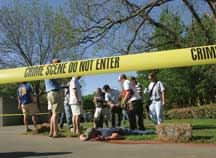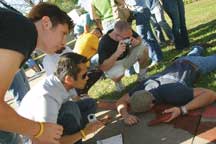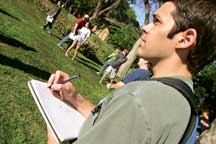More in academe
Due for a 'Digital Pearl Harbor'? | Matters of the heart | Learning squared | That competitive drive |
Down and Dirty on Spring Break |

CSI: Fort Worth
Sttudents learn that solving crime isn't as easy as those hip, attractive actors
make it seem on TV.
By Allison Speer '91

 On a bright spring day in April a group of students stumbled upon a triangle of yellow crime-scene tape behind the Moudy building. In the center: a fallen victim, gun in hand, blood staining the concrete below his head. On a bright spring day in April a group of students stumbled upon a triangle of yellow crime-scene tape behind the Moudy building. In the center: a fallen victim, gun in hand, blood staining the concrete below his head.
Of course the scene was meticulously staged by Adjunct Professor Jim Ferguson who teaches Crime Scene Investigation (CSI) -- TCU's own version of the hit television show via TCU's criminal justice program. In his class, which includes a surprise murder scene each spring semester -- it's up to the students to figure out whodunit.
During class students traveled in groups from the grassy crime scene to the witnesses (high school students from Ferguson's Mansfield classroom) to the frantic girl who screamed when she saw her dead boyfriend (Jim's 21-year-old son) sprawled face down on the ground.
There's no lack of enthusiasm in this class session; students came prepared with tape measures, sketch pads, cameras, video recorders and notepads where they scribbled answers as they drilled questions like, What kind of relationship did you have with the victim? Was he left-handed? Was he pale white, or just kinda white? One student found a shotgun shell and her group ran over to document the evidence.
 Nearly half of Ferguson's students are not criminal justice majors. They're people who are hooked on all things CSI and love solving a good mystery. Nearly half of Ferguson's students are not criminal justice majors. They're people who are hooked on all things CSI and love solving a good mystery.
"The class is about finding out the who, what, where, when, why and how," said Ferguson, a former Dallas and Norman, Okla., police officer who teaches full time in Mansfield. "I can't teach them to be an expert, but I can give them enough information so they can see how it's done, or more importantly, how it's not done."
For example, a crime is rarely solved in a neat, 40-minute time slot as it is in TV land. And sometimes the show does things that are misleading; scanning in a fingerprint only to find an identity match, photo and the person's exact location all in minutes.
Not so simple in real life, Ferguson explained. "In reality, a final fingerprint match has to be done by the human eye."
In class students learn that solving crime is like putting together a puzzle where the picture is missing, and all of the pieces are white.
"It gets students looking at the world around them and see that it's not always a safe place to be," he added.
 Ferguson has taught CSI and a criminalistics class for seven years. He knows when spring registration begins, as he receives a flurry of e-mails from students begging him to squeeze them into his class, which averages around 55. This semester, he capped out at 58. Ferguson has taught CSI and a criminalistics class for seven years. He knows when spring registration begins, as he receives a flurry of e-mails from students begging him to squeeze them into his class, which averages around 55. This semester, he capped out at 58.
One student successful in her pleas with Ferguson was senior Claire Moffatt, who spent the evening before the "murder class" watching a CSI marathon on DVD.
"In today's society there's so much hype about crime," she said. "It's human nature that we're so fascinated by it."
Ferguson stood by and watched as students made some CSI faux pas: standing in the blood, touching the bullet casing with bare hands, and missing the strands of hair he placed in the victim's right hand.
He chuckled and let it go, saying, "Now they'll learn how difficult it is to control a crime scene."
Contact Ferguson at j.ferguson@tcu.edu.
Comment at tcumagazine@tcu.edu.

TV or reality?
Ferguson dispels a few television myths that don't compute in the real world of law and order.
 TV: A Crime Scene Investigator (CSI) surveys the crime scene and directs all parties involved in the investigation. TV: A Crime Scene Investigator (CSI) surveys the crime scene and directs all parties involved in the investigation.
Reality: The uniformed officer who receives the call from dispatch is first on the scene and is in charge of the evidence that an on-the-scene crime lab technician, not a CSI, photographs and preserves. An investigator, or another higher authority then relieves the police officer. CSIs spend the majority of their time in an office or lab.
TV: A forensic investigator notices a stain on a
victim's shirt. After running one test, he'll
announce that the stain is black ink used only in a certain style of Mont Blanc pens.
Reality: Not every CSI can identify all substances. Investigators usually have specialties, such as firearms or treads.
TV: A CSI opens a resealable bag from the zipper closure and pulls out the evidence to analyze.
Reality: A lab technician or CSI will always cut the bag open at the opposite end or corner from where it was sealed. This decreases the possibilities of contamination.
TV: One young, hip character portrayed on Navy CSI (NCSI) has several tattoos, orange hair and is always shown drinking super-size soda from a convenience store.
Reality: Ferguson teaches students that they can't walk out of college, "be themselves" and get a job as a crime lab technician or medical examiner. Years of education and specialized on-the-job training -- often including experience as a street cop --must be achieved before one can attain such a position. These aren't jobs where they'll be making the big bucks, at least not right out of the classroom.
TV: A CSI takes a fiber from a jacket, analyzes it then prints out a list of manufacturers of that particular garment. The computer then identifies which stores sell it and the person's name who most recently purchased said jacket.
Reality: Most labs specialize in one or two processes. Police departments have to package evidence and send it to specific labs around the state -- and sometimes the country -- for testing, and they may not get results for weeks. Also, not all labs are stainless steel with a blue glowing background as seen on TV.

|



